
LAUREL (Cordia alliodora)
Trade Name
Laurel
Scientific Name
Cordia alliodora (Ruiz & Pav.) Oken
Family
Boraginaceae
Common Names
Laurel, Laurel Negro, Laurel Blanco (América Central y Ecuador); Bojón, Bojón Prieto, Hormiguero (México); Capá Prieto (Puerto Rico, Islas del Caribe); Cypre (Trinidad y Tobago); Nogal Cafetero, Nogal Mu, Moho, Mo, Canalete, Canalete de Humo, Prieto, Solera, Vara de Humo, Laurel Negro, Pardillo (Colombia); Laurel Negro, Laurel Prieto, Laurel Macho, Laurel Blanco, Laurel de Montaña, Laurel de Cerro, Laurel (Ecuador); Árbol de Ajo (Perú); Ajo (Bolivia); Pardillo, Canalete, Laurel Blanco, Cuajaro (Venezuela); Peterebí (Paraguay y Argentina); Freijo Branco, Louro Amarello, Pau Cachorro, Urua, Uruazeiro (Brasil). (414, 408, 424)
Scientific Name Synonyms
Cerdana alliodora R. & P.; Cordia alliodora (R. & P.) Cham; Cordia alliodora var. glabra DC.; Cordia cerdana (R. & P.) R. & S.; Cordia chamissoniana var. complicata R. & P. ex Chodat.; Cordia gerascanthus forma micrantha Chodat.; Cordia gerascanthus Jacq. (no Cordia gerascanthus L.); Cordia gerascanthus sensu Griseb.; Cordia gerascanthus var. subcanescens DC.; Cordia goudoti Chodat.; Cordia macrantha Chodat.; Cordia velutina Mart.; Lithocardium alliodorum (R. & P.) Kuntze.; Varronia tuberosa S. & M. (412)
Description Of The Tree
Botanical Description
A deciduous tree. In low lying humid regions it is a tall, thin tree with a narrow, sparse and open crown, minimum bifurcation forming a single trunk measuring 15-20 m, reaching heights of 40 m and up to 1 meter in DBH, although diameters of around 50 cm are the most common. In dry climates the specimens are smaller and poorly shaped, rarely reaching 20 m in height and 30 cm DBH. Smooth, clear brown/gray bark, although in some drier regions tends to show more bark fissures. Coppicing occurs. Generally inhabited by ants. Leaves simple, petiolate, and alternate, more or less sharp at the base, measuring up to 5 cm in width and 18 cm in length, underside covered in star-shaped hairs. Five-petal flowers measure 1 cm in length and width; 50-3000 flowers per inflorescence which produce nectar and are pollinated by bees and other insects. Fruit/seed generally develops only one embryo per fruit. Petals turn a brown color and act as a parachute for wind dispersion. Although the term seed is used principally to describe the dispersion unit, technically it is a dry fruit. (412)
Natural Habitat
Grows in a broad variety of climates and soils. Survives under light shade and a range of nutritional conditions, as demonstrated by its widespread occurrence in degraded or abandoned areas at some point used for pasture or for slash-and-burn agriculture. However, it requires full exposure and fertile soils in order to grow vigorously. Its range extends from low flatlands, coastal lands; deep, infertile, sandy soils containing little organic matter (entisols or oxisols), to fertile and deep volcanic soils rich in organic matter. Throughout the breadth of its geographic range it occurs in a broad range of ecological conditions ranging from very moist to seasonally dry. (412). Found in association with Tabebuia heterophylla, Cedrela odorata, Hymenaea courbaril, Ficus laevigata, Cecropia peltata, Crescentia alata, Crescentia cujete, Bursera simaruba, Tamarindus indica, Cochlospermum vitifolium, Acrocomia mexicana, Andira inermis, Bellotia mexicana, Bernoullea flamea, Calophyllum brasiliense, Cordia dodecandra. (425)
Flowering And Fruiting Months
Flowers from June to November. Flowering season coincides with the dry season and the defoliation period depends on its location. Fruit ripens from September to April.
Flowering
- Jan.
- Feb.
- Mar.
- Apr.
- May.
- Jun.
- Jul.
- Aug.
- Sep.
- Oct.
- Nov.
- Dec.
Fruiting
- Jan.
- Feb.
- Mar.
- Apr.
- May.
- Jun.
- Jul.
- Aug.
- Sep.
- Oct.
- Nov.
- Dec.
Regeneration Ease
Regenerates easily in open clearings; generally through seeds. Seed dispersal by wind. (425) The potential to handle regeneration in pure stands (402, 575, 576) or agroforestry associations (591) and for timber-yielding products of greater added value has been widely demonstrated.
Natural Distribution
It is the most widely dispersed species in its genus and occurs naturally from the north of Mexico through Central and South America to Paraguay, the southern part of Brazil, and to the north of Argentina. Also appears in the majority of the Caribbean Islands. (412)
Plantations Available?
Forest plantations established in Central America, South America (in Suriname in 1967), and Nigeria (in 1922). Now the species has begun to become important in reforestation programs in the following countries: Brazil, Congo, Colombia, Costa Rica, Ecuador, Ivory Coast, Puerto Rico, Sierra Leone, Trinidad, Uganda, Venezuela. Has been used in permanent plantings with coffee, cacao, coconut, guava, poró, and cedar; in temporary plantings with plantain, rice, and yucca. (425)
Timber Local Uses
It has been used in sculptures, turned articles, exterior and interior construction, tool handles; carpentry in the form of rungs, batten and boards, fine furniture, flooring, doors, toys, wainscoting, auto/truck body, bridges, desk articles, rafters, sports equipment, posts, luxury furniture, oars, vessels, cooperage, cabinets, parquet, toys, baseboards, plywood, decorative veneer, musical instruments, or parts of these. (408, 412, 425)
Non Timber Uses
It is used for: wounds, edema, acne, burns, rashes, rheumatism, antispasmodic, as an emetic and diuretic (Bark). Intestinal diseases, as an anti-inflammatory for abscesses and tumors, tooth aches (Stalk). The leaves contain camphor. The cooked flower is an emollient. The residual paste remaining after extracting the oil from the seeds is forage and is used as livestock feed. The cottony fiber surrounding the seeds is used in the industry as a thermal and acoustic insulator in refrigeration chambers and aircraft. (425) It is classified as a honey-bearing plant and is also used in agroforestry systems for its shade. (412) The fruit is edible, the leaves are cooked to be used as tonics and stimulants, particularly for colds and lung problems, salves are produced from crushed seeds to cure skin diseases. (423)
-
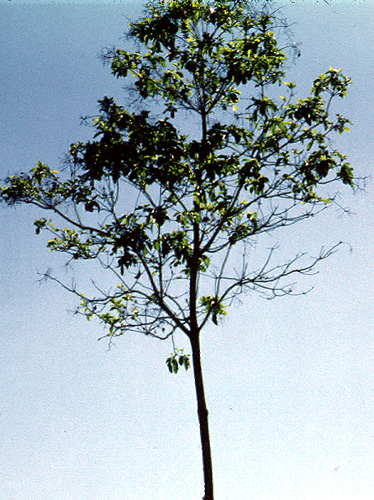 Tree Photo
Tree Photo
-
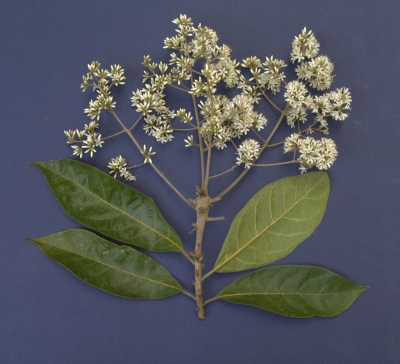
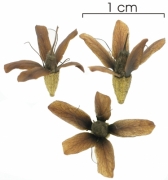
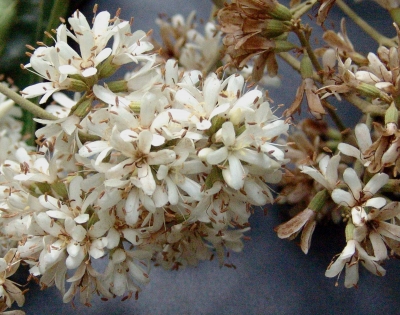 Photos Of Leaves Flowers Fruit
Photos Of Leaves Flowers Fruit
-
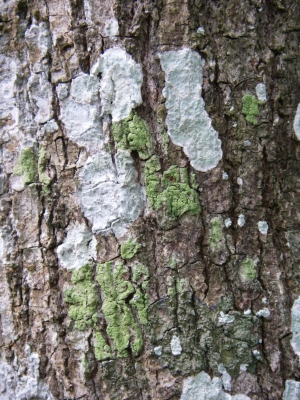 Bark Photo
Bark Photo
Wood Identification
Anatomic Description Of Wood
Growth rings visible to the naked eye, indicated by a line of terminal parenchyma and a row of slightly larger pores set out in a concentric pattern. Diffuse porosity, small to large relatively evenly distributed pores barely visible to the naked eye, moderately numerous (65 to 125 pores per mm2), single, in short radial multiples and, quite frequently, in small bunched groupings with a significant tendency to being set out in tangential rows, the majority occluded by tyloses. Terminal parenchyma visible to the naked eye, also vasicentric, aliform, and confluent aliform visible under a 10x lens in a moistened cross-section. Radii visible to the naked eye in the three (3) sections. Gum ducts absent. Stratification absent. (425)
-
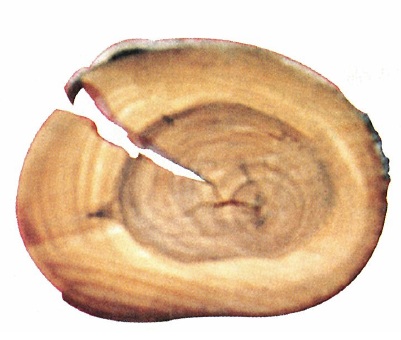 Photo Of Fresh Cross Cut Log Section
Photo Of Fresh Cross Cut Log Section
-
Wood Macro Photo Transversal Plane
-
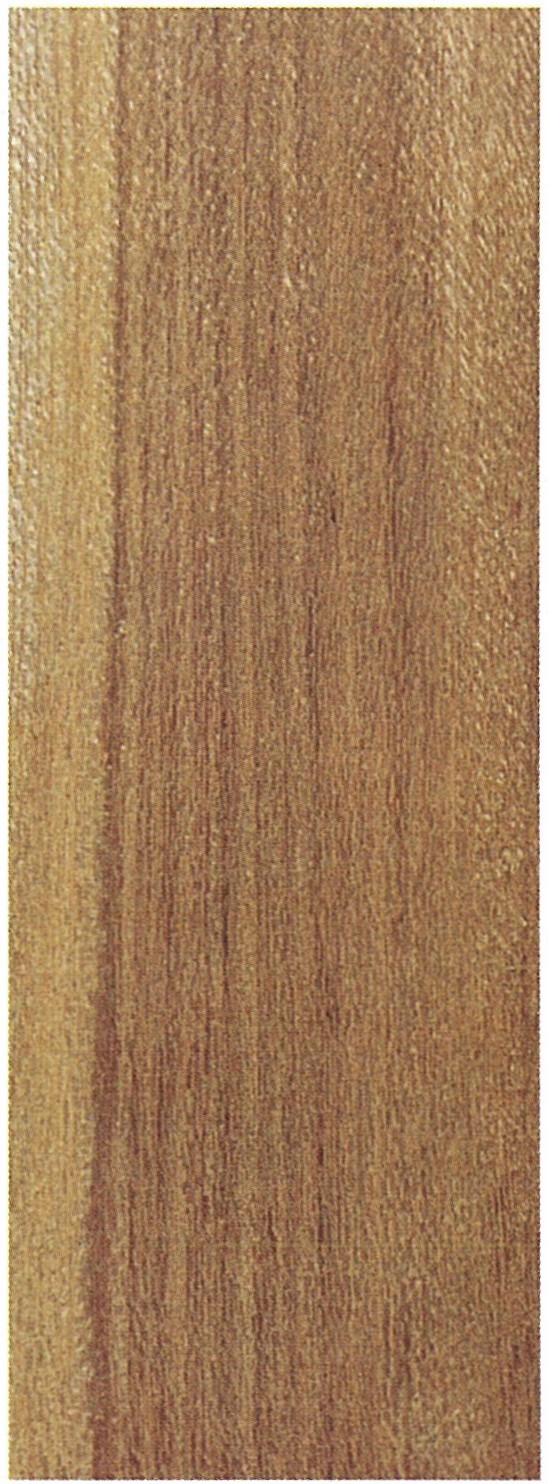 Wood Macro Photo Radial Plane
Wood Macro Photo Radial Plane
-
Wood Macro Photo Tangential Plane
-
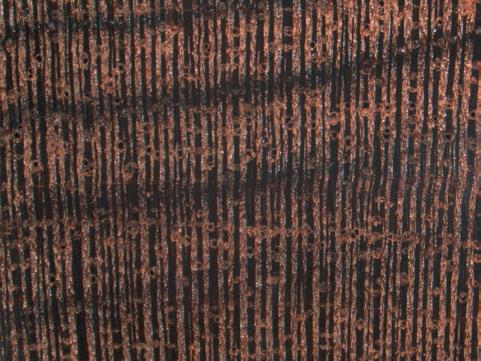 Wood Micro Photo Of Transversal Section
Wood Micro Photo Of Transversal Section
Specialized Bibliography For This Topic
- 56 - Manual de Identificación de Especies Forestales de la Subregión Andina.
- 408 - Manual para la comercialización de maderas que se comercializan en el departamento de Tolima
- 425 - Cordia alliodora (Ruiz & Pav.) Oken (1833).
Availability
Cites Status
Unrestricted
ABUNDANCE LOW (Relative abundance of standing timber over 40 cm d.b.h. < 2 m³/ha)
Grows well in industrial plantings with intensive management and without animal damage to roots, in Esmeraldas, Ecuador. There, the estimated mean annual increment is 8-12 m3/ha/yr in 23 year rotations, final harvest of 160 to 175 trees/ha. (402)
Certified Forest Producers
maderascultivadas
Specialized Bibliography For This Topic
- 402 - Plantaciones forestales productivas en los trópicos de Ecuador con Laurel, Cordia alliodora (Ruiz y Pav.) Oken
General Wood Description
Odor
Has a characteristic aromatic odor. (423) When dry, no distinctive odor. (424)
Color
Sapwood yellowish to light maroon in color; gradual to abrupt color transition to heartwood from pale golden maroon, or yellowish chestnut or olive brown or tobacco, with longitudinal woodgrain of a darker color; vascular lines clearly visible to the naked eye. (408)
COLOR INDEX (1=Black, 7=Light yellow,white)
4
Grain
Straight to irregular grain. (408)
Texture
Light to accented veining. (424)
Luster
Medium to high. (408)
Natural Durability
The heartwood is very resistant to termites, rotting in-ground and fungi, although sapwood is considerably more susceptible. (408, 412)
Natural durability index (1= Very high durability, 7=Vey low durability)
4
Resistance To Impregnation
Wood difficult to treat through creosote immersion. Creosote treatment with vacuum and pressure is moderately difficult. (408)
Specialized Bibliography For These Topics
- 408 - Manual para la comercialización de maderas que se comercializan en el departamento de Tolima
- 412 - Árboles de Centroamerica, Un Manual para extensionistas
- 424 - Fichas técnicas sobre características tecnológicas y usos de maderas comercializadas en México
Wood Physical Properties
Basic Density or Specific Gravity (O.D. weight/vol. green) (g/cm³)
0.39 (408)
Air-dry Density (Weight and volume at 12%MC) (g/cm³)
0.45 (408)
Normal Shrinkage Tangential (Saturated to 12%MC) (%)
4.2 (408)
Total shrinkage Tangential (Saturated to 0%MC) (%)
6.6 (408)
Normal shrinkage Radial (Saturated to 12%MC) (%)
1.7 (408)
Total shrinkage Radial (Saturated to 0%MC) (%)
3.1 (408)
Volumetric Normal shrinkage (Saturated to 12%MC) (%)
5.9 (408)
Drying Defects
Moderate seasoning speed; light checking and warping when air dried. (424)
Recommended Dry Kiln Schedule
For conventional kiln drying, U.S. T6-D2 programs for one inch lumber, and T3-D1 for two inch lumber. (424)
Dimensional stability ratio (Total Tangential Shrinkage %/Total Radial Shrinkage %)
2.1 (408)
Specialized Bibliography For This Topic
- 408 - Manual para la comercialización de maderas que se comercializan en el departamento de Tolima
- 424 - Fichas técnicas sobre características tecnológicas y usos de maderas comercializadas en México
Wood Chemical Properties
Wood Mechanical Properties
Bending Strength (MOR),12%MC (kgf/cm²)
724 (408)
Stiffness (MOE) 12%MC (kgf/cm²)
86 000 (408)
Compression parallel to fiber 12%MC (kgf/cm²)
325 (408)
Compression perpendicular to fiber 12%MC (kgf/cm²)
57 (408)
Shear strength radial 12%MC (kgf/cm²)
73 (408)
Janka hardness (side) 12%MC (kgf)
247 (408)
Janka hardness (end grain) 12%MC (kgf)
277 (408)
Specialized Bibliography For This Topic
- 408 - Manual para la comercialización de maderas que se comercializan en el departamento de Tolima
- 424 - Fichas técnicas sobre características tecnológicas y usos de maderas comercializadas en México
- 400 - Las Maderas en Colombia
Workability
Sawing
Performs well in sawing. (424)
Rotary Veneer Cutting
Performs well in peeling. (402)
Sliced Veneer
Attractive veneer. (402)
Machining
Wood easy to work with hand tools and conventional machinery. (424)
Planing
Performs well in planing. (424)
Moulding
May be shaped, but the quality of the surface may be poor. (424)
Boring
Performs well in drilling. (424)
Mortising
Performs well in mortising. (424)
Nailing
Performs well when nailed or screwed. (424)
Gluing
Easy to glue. (424)
Sanding
Performs well in sanding. (424)
Finishing
Smooth finish. (424)
Response To Hand Tools
Wood easy to work both with hand tools and conventional machinery. (424)
Substitute Species
Cedrela angustifolia Sessé (Cedar); Swietenia macrophylla (Mahogany). (424)
Specialized Bibliography For This Topic
- 402 - Plantaciones forestales productivas en los trópicos de Ecuador con Laurel, Cordia alliodora (Ruiz y Pav.) Oken
- 424 - Fichas técnicas sobre características tecnológicas y usos de maderas comercializadas en México
REFERENCED USES
End Uses Summary
EXTERIOR, bridges, posts, GENERAL HOUSING, doors, parquet, wainscoting, , FURNITURE AND CABINETS, fine furniture, desks, floors, cabinets, PLYWOOD AND VENEER, plywood, decorative veneer, TURNING, TOOLS, tool handles, CONTAINERS, cooperage, auto/truck bodies, NAVAL CONSTRUCTION, oars, vessels, OTHER AND MUSICAL INSTRUMENTS, musical instruments, sculptures, ladder rungs, (408, 412, 425).
Exterior General
- 412 - Árboles de Centroamerica, Un Manual para extensionistas
Bridges
- 425 - Cordia alliodora (Ruiz & Pav.) Oken (1833).
Crossties
- 425 - Cordia alliodora (Ruiz & Pav.) Oken (1833).
Flooring
- 412 - Árboles de Centroamerica, Un Manual para extensionistas
Parquet
- 412 - Árboles de Centroamerica, Un Manual para extensionistas
- 425 - Cordia alliodora (Ruiz & Pav.) Oken (1833).
Frames
- 412 - Árboles de Centroamerica, Un Manual para extensionistas
Furniture Cabinets
- 412 - Árboles de Centroamerica, Un Manual para extensionistas
- 425 - Cordia alliodora (Ruiz & Pav.) Oken (1833).
Furniture, Luxury
- 408 - Manual para la comercialización de maderas que se comercializan en el departamento de Tolima
Furniture, Common
- 408 - Manual para la comercialización de maderas que se comercializan en el departamento de Tolima
Cabinet
- 425 - Cordia alliodora (Ruiz & Pav.) Oken (1833).
Decorative veneer
- 408 - Manual para la comercialización de maderas que se comercializan en el departamento de Tolima
- 412 - Árboles de Centroamerica, Un Manual para extensionistas
Ornaments
- 408 - Manual para la comercialización de maderas que se comercializan en el departamento de Tolima
Tool Handles
- 425 - Cordia alliodora (Ruiz & Pav.) Oken (1833).
Boats
- 408 - Manual para la comercialización de maderas que se comercializan en el departamento de Tolima
Other & Musical Instruments
- 408 - Manual para la comercialización de maderas que se comercializan en el departamento de Tolima
- 425 - Cordia alliodora (Ruiz & Pav.) Oken (1833).
Please Provide Information To View Producer Information